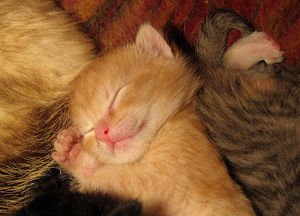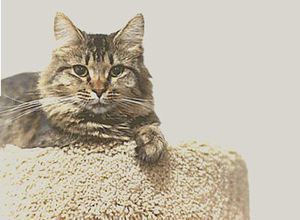Cat adoption
 From Citizendium - Reading time: 6 min
From Citizendium - Reading time: 6 min
Cat adoption is the process of a person taking custody of a cat. It can happen informally when a neighbor's cat has kittens and puts them up for adoption, or more formally when visiting a humane society or shelter, choosing a cat, filling out paperwork, and taking a kitten or cat home. It involves a commitment to take responsible care of a pet. There have been instances when stray cats are taken in by their new families; one scientist explained that sometimes cats...:
| ‘ | ...adopt their new families. When I was a kid we had one show up at the back door out of the blue and it stayed for ten years. | ’ |
Adopting from the humane society usually requires paying a fee, particularly for kittens, although a number of no-fee adoption programs have helped encourage adoptions, and lessen the need for euthanasia.[1] In Salt Lake City, Utah, a no-fee adoption program caused adoptions to increase from 702 in 2008 to 1,038 in 2009, and euthanizations have decreased from 2,356 to 2,778.[1] In instances, the no-fee adoption policy applies to adult cats, who are less likely to find caretakers.[1]
| ‘ | Cats, especially adult cats, are at tremendous risk at shelters around the country," Weiss said. "In almost any part of the country, cats are much less likely to leave a sheltering facility alive.[1] | ’ |
During summers, cat shelters tend to "overflow", spurring a movement to lower fees or drop them altogether.[2] A Michigan shelter promoted adoptions with a free "multipoint inspection" including spray/neuter surgery, vaccinations, behavioral evaluations and grooming.[2] The campaign called for adopting "Certified Pre-Owned Cats" touting "no money down, no financing and no payments."[2] During the recession, perhaps because people had fewer resources to care for cats, the numbers of cats in shelters was higher. At a center in North Carolina (U.S. state), the numbers of pets at a shelter was 825 compared with 700 for a similar period for the previous year.[2] Kittens get adopted quickly.[2] A study by the American Association for the Prevention of Cruelty to Animals suggested there were no substantive differences between adopting persons who paid a fee, or who didn't pay a fee.[2] In New Jersey, a creative promotion campaign suggested that people adopt a "black cat" around Halloween.[3]
In most instances, adopting a cat involves filling out paperwork so that volunteers can get more insight into whether a person or family would make a responsible pet owner. Some adoption centers have downloadable application forms. Some centers provide a month's worth of pet insurance as an incentive for people to adopt.[4] In the United States of America, adoption usually means visiting a humane society, although there are some grass roots volunteer rescue groups that seek owners for cats.[5]
| ‘ | Within the limits of our spaces and money
We cannot and will not say "NO" to them AWAN, in it's hands-on way, gives shelter and sanctuary while fighting the ancient battle against cruelty, ignorance, and indifference. Each of us feels the tragedy of not being equipped to do it all. The fact that we can't save every animal who needs us is heart breaking! For all the work of dedicated rescuers, the suffering seems to be increasing. We need HELP to continue and expand our effort. Every day more unwanteds are born to lives of horrific neglect and pain. Without more money we have no power to turn this around.[5] |
’ |
Many adoption centers are run by volunteers who work hard to prevent cruelty to cats, who rescue them and promote efforts to keep cats from starving or being neglected.[5]
The American Humane Association dubbed the month of June as "Adopt-A-Cat" month.[6] There was an unofficial estimate that there were more than 1,000,000 homeless cats in the United States.[6]
A shelter gave reasons for people to adopt cats:
- Cats are very clean; they bathe themselves.
- Cats can be left alone while you work.
- A cat's purr is calming and relaxing.
- Cats reduce your blood pressure and fight depression and loneliness.
- Cats are comfortable in small spaces like apartments.
- Cats cost less to spay/neuter than dogs.
- Just 15 minutes daily playtime will satisfy a cat.
- Cats are easy to litter train.
- Cats do not need to be walked.
- Cats can provide up to 20 years companionship.
- And they're cute and cuddly.[6]
On the downside, reasons not to adopt a cat, all of which apply to dogs except that dog allergy is rarer, include:
- Humans may be allergic to the cat's dander.
- Cost of feeding, trips to supermarket.
- Having to make arrangements if you'll be away from home for extended periods.
- Cost of veterinarian shots, treatments.
- In some apartment buildings, neighbors may object.
Some see a trend towards greater adoption of cats over dogs, since more households have both adults working, and there's nobody home during the day to look after a dog; in contrast, cats are easier to leave unattended for long stretches of the day.[7] Cats are independent-minded, and don't like to be put in groups like cattle; indeed, the phrase herding cats is an expression about how difficult it is to get intelligent people to all do the same thing.
By one account, the celebrity cat named "Morris the Cat" was about to be euthanized, but was rescued by a shelter worker who pitched the idea to a marketing person.[6] Since then, Morris has become the most recognized cat and has appeared on magazine covers, endless commercials and on national talk shows as a "spokescat."[6]
Many adoption centers try to evaluate whether humans would be good caregivers for a cat. But it's difficult to tell. A 35-year old dog groomer ran into trouble with animal welfare officers after she placed advertisements on the Internet for "gothic cats"; officers learned she had been piercing kittens on the neck and ears and putting jewelry on the cats.[8] A court case resulted, and the woman was found guilty of animal cruelty, despite the fact that defense lawyers had argued that parents allow their children to get piercings[8] and tattoos in some instances. Some controversies surround the issue of whether to declaw or not; it used to be a widely accepted practice, but recently there have been objections that declawing a cat has drawbacks and can trigger ethical issues.[9] Some animal protection advocates call declawing "barbaric" while the American Veterinary Medical Association has stopped short of disavowing it, particularly if declawing makes a cat more readily adoptable.[9]
References[edit]
- ↑ 1.0 1.1 1.2 1.3 Brian Passey. Fee waivers boost cat adoptions, USA Today, 2010-01-03. Retrieved on 2010-03-08.
- ↑ 2.0 2.1 2.2 2.3 2.4 2.5 Cat Shelters Overflow During Summer: Michigan Shelter So Crowded It's Reducing Adoption Fees to Lure New Owners, CBS News, Aug. 17, 2009. Retrieved on 2010-03-08.
- ↑ Adopt a black cat at pre-Halloween rescue event, The Jersey Journal, October 25, 2009. Retrieved on 2010-03-08. “An animal rescue group and a Jersey City is hosting a pre-Halloween myth-buster event today. The adopt-a-black-cat event is intended to prove that the subjects of outdated Halloween superstitions make purrfect pets. It takes place from 1 to 4 p.m. at the Alley Cat Gallery, between Fourth and Fifth streets in the East-West alley between Jersey Avenue and Coles Street.”
- ↑ Adopt a Cat!, Liberty Humane Society, 2010-03-08. Retrieved on 2010-03-08.
- ↑ 5.0 5.1 5.2 A.W.A.N., AWAN -- Animal Welfare Adoption Network, 2010-03-08. Retrieved on 2010-03-08. “We have a 20 year history, 501c(3) status. The heart of our mission is the fostering of cats and dogs in Network homes until loving adoptions are arranged. Most of our budget pays vets for spay/neuter, repair of the abused and support of special needs animals. We encourage No-Kill, Sad to say, whenever an area shelter goes no-kill our modest resources are stretched even thinner as the rejects are dumped, surrendered to us, or left to starve.”
- ↑ 6.0 6.1 6.2 6.3 6.4 Joan Lowell Smith. Morris the Cat isn't finicky about this work, nj.com, June 18, 2008. Retrieved on 2010-03-08. “What better way to celebrate Adopt-A-Cat month, started by the American Humane Association, than to salute the combined efforts of AHA and 9Lives cat food to find homes for 1 million homeless cats?”
- ↑ LINDA SASLOW. Adoption Of Cats Increasing, The New York Times, June 24, 1990. Retrieved on 2010-03-08. “CATS are becoming the pet of choice on Long Island. Because of economics, convenience and housing regulations, officials of the Island's pet adoption centers say, the percentage of cat adoptions is rising.”
- ↑ 8.0 8.1 "Gothic Kitten" Woman Convicted of Cruelty: Pennsylvania Woman Will Face Sentencing in March for Piercing 3 Kittens' Ears, Neck, CBS News, Feb. 4, 2010. Retrieved on 2010-03-08. “A northeastern Pennsylvania woman who marketed "gothic kittens" with ear and neck piercings over the Internet has been convicted of animal cruelty.”
- ↑ 9.0 9.1 Should You Declaw?, Washington Post, January 16, 2005. Retrieved on 2010-03-08. “Declawing wasn't always such a controversial subject -- many vets used to perform the surgery as a matter of course (it wasn't unheard of for them to offer a discount-declaw while spaying your cat, for example). These days, it's a different story: Animal-protection advocates have called the procedure barbaric, and at least one California town has banned it entirely.”
 KSF
KSF
